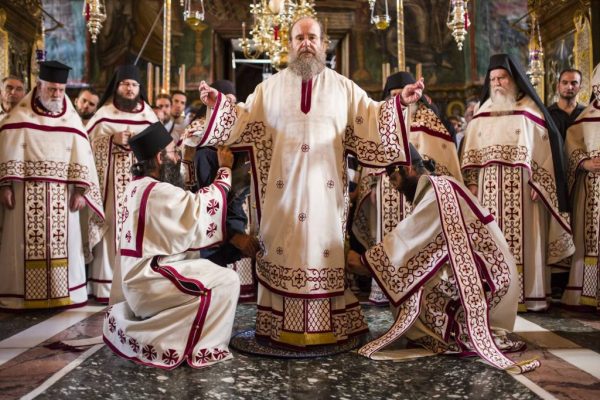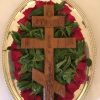“My soul shall rejoice in the Lord, for He has clothed me with the garment of salvation; He has covered me with the robe of gladness; as a bridegroom He has set a crown on me; and as a bride adorns herself with jewels, so my God has adorned me.”
With these words from Isaiah, the priest begins the ritual of dressing prior to the Liturgy. With each item of his priestly garments, another verse from the Scriptures (Old Testament) will be recited. The verse not only relates to that item of clothing, but offers both a mystical explanation as well as a meditation for the priest himself. The priest begins the Divine Liturgy by becoming an allegory.
To understand such a statement, reflect with me on this passage from Galatians:
“It is written that Abraham had two sons: the one by a bondwoman, the other by a freewoman. But he who was of the bondwoman was born according to the flesh, and he of the freewoman through promise, which things are an allegory. For these are the two covenants: the one from Mount Sinai which gives birth to bondage, which is Hagar—for this Hagar is Mount Sinai in Arabia, and corresponds to Jerusalem which now is, and is in bondage with her children—but the Jerusalem above is free, which is the mother of us all.” (4:22-27)
St. Paul is doing nothing strange in his treatment of the Old Testament. Jews and Gentiles would be familiar with this manner of reading. It is interesting that some English translations will render this as “which things are figurative…” or “which things are symbolic…” Clearly showing that we have a hard time expressing what is going on here. In modern usage, “allegory” has come to be confined to a particular form of literary symbolism, one where one thing is meant to stand for something else. CS Lewis’ childrens’ book, The Lion, the Witch, and the Wardrobe, is an example of such allegory. Aslan stands for Christ. This, however, is not what St. Paul means.
St. Paul is using the term in its very broad, ancient sense, in which allegory means the use of one word in order to convey another. It is an understanding that there is a meaning hidden beneath and within a text. Indeed, it would not have been uncommon for such an approach to suggest that the hidden meaning is the “true” meaning, visible to those with “eyes to see.” It is similar to Christ’s declaration that God has purposely hidden certain things for the sake of our salvation. He does not “cast his pearls before swine.”
This same hiddenness is common throughout the Scriptures and across the history of the people of God. When God speaks with Moses on the mountain, He shows Him the heavenly (here we can say “real” and “true”) tabernacle. He then gives instructions that the earthly tabernacle is to be constructed “according to this pattern.” That structure is described in great detail in the Scriptures. However, it is clear that what is being built is important and true, because it is a reflection of the heavenly tabernacle which Moses himself saw. When Israel gathers at this earthly tabernacle, they are not there merely to be reminded of something Moses saw. Rather, the earthly representation makes present and participates in the heavenly. It is a sacramental understanding. We may also say that it is an allegory (in St. Paul’s sense). If it is seen as “merely” a human construct, it is not rightly seen. The Ark of the Covenant could be read as nothing more than a human construct, but such a reading would be deadly, as in the case of Uzzah, who wrongly touched the Ark and died.
It is impossible to read the Book of Hebrews and not see this. There, the whole of the Old Testament pattern and practice of worship is described as a shadow of something heavenly and true that is now fulfilled in the death and resurrection of Christ. Christ is seen as the true High Priest who has entered into the “tabernacle not made by hands.” There He offers the perfect sacrifice of which every previous sacrifice was only a figure. What had been hidden, as St. Paul tells us, has now been made known in Christ.
This way of doing and seeing, quite importantly, is not confined to the pages of Scripture and the practices of the past. It is engrained in our faith and our Orthodox way of life. Seated with His disciples, Christ takes bread, blesses, breaks, and gives it to them saying, “This is my Body…” The pattern is being maintained and will become and remain the heart of the Church’s worship.
The simplest way to express this sacramental revelation is: “This is that.” This is not a mere reminder of that, or a figure, or a symbol (if by that we mean something that stands in for something else). Rather, “this” truly and really is “that.”
The Incarnation of Christ teaches us not just that God became a man, but that the earth has a capacity for the heavenly. It not only has a capacity for the heavenly, but is so constructed that it cannot be rightly understood and lived in unless and until we see and regard that heavenly which is hidden within it. God has purposely hidden these “treasures” from us so that we might become the kind of persons who know how to see and find them. So, we lost paradise and came “into this world” (St. Basil’s language for the Fall). But having come into this world, we only return to paradise when we find it hidden here (where we are). That finding is the fruit of an inward repentance and the acquisition of the Spirit. I would say, carefully, that by “repentance,” I am describing turning away from the “not seeing, not seeking” way of life.
Christ said, “Ask and you’ll receive, knock and it will be opened, seek and you shall find.” What we fail to understand is that the asking, knocking, and seeking are states of the heart that must be nurtured into a way of life. Christ came to us speaking in parables. In truth, He has been speaking to us in parables since the very beginning. What was once parable continues in sacrament, and in a kind of existence that is “on earth as it is in heaven.” To see the parable is to perceive heaven and to begin to find the door by which we enter.
And now, I return to the priest as he vests for the service. Those vestments, the “garment of salvation,” and the “robe of gladness,” are those vestments that we lost in paradise when we fell, and our eyes were opened and we saw ourselves as “naked” (and were ashamed). This re-clothing is similar to our Baptismal garment: “As many as have been baptized into Christ, have put on Christ [like a garment]. From the robe of the priesthood in the Old Testament to that of the newly-robed Christians in the New, the priest of the New Covenant is robed as Christ, who alone is our “Great High Priest.” And so this priest becomes the “allegory,” the “sacrament” and “parable” of Christ. This is that. This priest will stand where Christ alone can stand, and offer the “bloodless sacrifice.”
In St. Basil’s Liturgy, during the Litany of Supplication, the priest silently offers a prayer. In part he prays:
…accept us as we draw near to Your Holy Altar, so that we may be worthy to offer to You this reasonable and bloodless sacrifice for our sins and for the errors of Your people. Having received it on Your holy, heavenly and ideal altar as an offering of sweet spiritual fragrance, send down on us in turn the grace of Your Holy Spirit. Look down on us, O God, and observe this our worship. Accept it as You accepted the gifts of Abel, the sacrifices of Noah, the whole burnt offerings of Abraham, the priestly offices of Moses and Aaron, and the peace-offerings of Samuel. As You accepted this true worship from Your holy Apostles, so now, in Your goodness, accept these gifts from the hands of us sinners, O Lord, that having been permitted to serve without offense at Your Holy Altar, we may receive the reward of wise and faithful stewards on the awesome day of Your just retribution…
This offering is gathering together all of the offerings through the ages: the gifts of Abel, the sacrifices of Noah, the whole burnt offerings of Abraham, the priestly offices of Moses and Aaron, and the peace-offerings of Samuel. These are now offered to be received, not on this earthly altar, but “on Your holy, heavenly and ideal altar.” This is that.
This is the pattern of our life (for all of us), for we were first established in paradise as priests to offer thanks to God. What we lost, Christ has restored.















